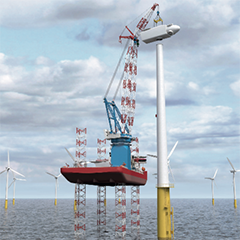For a long time we at PES have been saying that components in the wind industry are getting bigger and bigger and obviously this includes the tools of the trade. How much more increase can there be in size and how does this affect the weight?
Huisman from the beginning
Before looking at the developments in the wind industry, let’s take a closer look at Huisman, one of the manufacturers of offshore wind tools and cranes, and start at the beginning. Huisman, founded in 1929 and was originally a construction company for steel structures and derricks.
In 1987 Huisman joined forces with engineering company ITREC to develop steel construction projects entirely under its own management. In 1983, during the early ITREC days, the mast crane concept was developed: a compact and innovative crane design for heavy offshore lifts: the Heavy Lift Mast Crane. Another important development from the early days is Active Heave compensation. Currently, this system is also delivered in an electric version, with frequency controlled motors. Unlike in the second half of the eighties, when everyone considered 300m water depth to be extremely deep, indeed nowadays, we consider this to be shallow water. With innovation being at the heart of the company, Huisman kept on developing crane designs towards the foreseen future applications, in deeper water. Good examples are the newly designed Hybrid Boom Crane, which won the OSJ innovation of the Year Award in 2015 and the set of two 10,000mt cranes which are currently under construction for Heerema’s Sleipnir, the world’s largest to date.
Building on the successful operation of the existing Huisman cranes, for the installation of offshore wind turbines, such as the crane on board the Rambiz, the company introduced a range of cranes and tools tailored toward wind turbine installation and maintenance. These cranes and tools are a result of many years of research, design and operational experience, based on the company’s determination to design and deliver new solutions, which add value to the market’s existing technologies.
In addition to cranes, Huisman entered the market for Pipelay systems in 1996, with a Rigid-lay system for the Acergy Falcon. This was the take-off for an impressive number of Flex-lay, S-lay, J-lay and Reel-lay systems and combinations of these: Multi-lay systems.



























